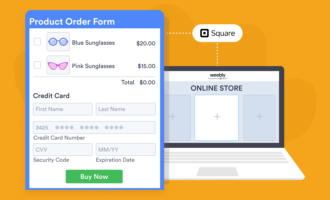Weebly and Squarespace are website builders designed for just about anyone, including people without coding experience. They both use drag-and-drop controls and a visual interface to make building a website the digital equivalent of making a collage.
Despite their fundamental similarities, though, each service has carved out its own niche among users. Some love Squarespace’s famously sleek templates, for instance. Others want to try out a free site before upgrading, which is something only Weebly allows.
Before you decide on Weebly vs Squarespace, consider the following key differences.
1. Squarespace has a slightly steeper learning curve than Weebly
Both Weebly and Squarespace use What You See Is What You Get editors, where the visual display in editing mode shows you what the published site will look like. (This style of editor is abbreviated WYSIWYG, pronounced “WIZ-ee-wig.”)
This makes editing your site fairly simple. But between the two WYSIWYG editors, Weebly is the best choice for those new to site building. The Squarespace editor isn’t difficult to master, but no one can compete with Weebly’s simple, intuitive controls. In fact, Weebly has been described as “extremely easy to use.”
2. Squarespace templates are often regarded as looking good on any platform
Squarespace’s templates are consistently referred to as stunning, beautiful, and stylish. Weebly’s menu of several dozen free templates provides lots of great options as well, but Squarespace has the edge on out-of-the-box template design.
Both Weebly and Squarespace templates are responsive, so you don’t have to worry about changing designs for mobile view with either. And both platforms have a thriving market for third-party designs, so if you don’t find a free template you like, you can always extend your search.
3. Weebly’s site editor doesn’t allow as much design flexibility as Squarespace’s
Weebly’s focus is on simplicity, which means it has a fairly structured (and less flexible) design template. You’re tied to the template’s layout, which prevents you from placing elements anywhere you want on the page. That level of uniformity tends to make Weebly sites look similar — unless you spend a lot of time changing fonts and adding design elements with apps.
With Squarespace, on the other hand, you can drop images and text wherever you want. (It’s important to note that while freedom of design can often be a good thing, it can also be risky if you don’t have an eye for design.)
4. Weebly provides more apps than Squarespace
The Weebly App Center is full of more than 350 software additions, including integrations with third-party services, marketing tools, and additional design elements. Weebly’s apps let you embed custom online forms through Jotform, quickly add an FAQ section to your site, or build a custom pricing table into your homepage.
You can accomplish these things on Squarespace, too, but you may have to copy and paste lines of code or build that FAQ from a blank page. Weeby’s apps make these features easier to use. The Squarespace Extensions marketplace tends to focus on third-party integrations associated with e-commerce and marketing. Last time we checked, Squarespace had 32 extensions available.
5. Weebly has a free plan
If you use Weebly’s free plan, Weebly branding will appear on your site, and you won’t be able to connect your own domain. Instead, you’ll get a subdomain with Weebly’s name in the URL. Still, you can build a fully functioning website — that even includes an e-store — without spending a dime.
Squarespace offers a 14-day free trial for new users, but there’s no free site option. Here’s a breakdown of Squarespace pricing:
- Personal: $16 per month
- Business: $23 per month
- Basic Commerce: $28 per month
- Advanced Commerce: $52 per month
Compare that to Weebly’s plans:
- Free
- Personal: $10 per month
- Professional: $12 per month
- Performance: $26 per month
Weebly and Squarespace each have their strengths. Squarespace’s interface can induce anxiety, but it’s tough to beat the look of the final product. Weebly makes things easy on its users, but that comes at a cost in terms of creativity and differentiation.
Luckily, you can do some hands-on research before you decide. Try them both without spending a penny, then commit after you have some experience with each.









































































Send Comment: